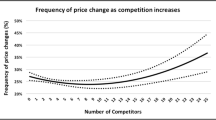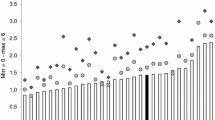Abstract
This paper extends a model by Deneckere et al. (J Ind Econ 40:147–156, 1992) to a multi-regional framework. It is assumed that some consumers are loyal to their respective regional firms, while others prefer the nationwide firm’s product. A third type of consumers is sensitive to price. With simultaneous price-setting, it is profitable to undercut or to set the consumers’ reservation price depending on the relative group sizes. With each type of leader–follower game, all firms set the reservation price. In this case, the most profitable scenario for the nationwide firm is to act as a price follower. The model is illustrated by the Austrian newspaper industry, represented by a nationwide firm that enjoys a national market share of over 50 per cent but nevertheless faces strong competition from regional producers in most regional markets. Actual price-setting behaviour is documented and interpreted for the observation period 1979–2003. It is shown that (i) the regional firms’ prices were identical to the nationwide firm’s most of the time, (ii) the nationwide firm almost always acted as a price follower, and (iii) a particular market entrant’s aggressive undercutting was an inept strategy.




Similar content being viewed by others
Notes
Deneckere et al. (1992) assume zero production costs and strictly no entry, which leads to the same results.
\(p_2 =p_2^l \) can never be profit-maximising for firm 2 as firm 1 sets the reservation price in any case, firm 2’s profit will always be higher from setting the reservation price, too, because \(p_r (k_2 +0.5k_c )>p_2^l (k_2 +k_c )\).
Firm 2 is indifferent in cases of respective equalities of consumer group sizes that have been left out to save space.
To be precise, in 1989, the Social Democratic Party of Austria sold the majority of the Arbeiter-Zeitung to a private company, which published the final issue on 31 October 1991.
By inclusion of its regional editions Oberösterreichisches Tagblatt and Salzburger Tagblatt.
A detailed documentation of reaches, circulations, retail prices and ownerships of the Austrian newspaper market can be found in Sardadvar (2013).
These are the only cases during the observation period when a competitor charged different prices for a regional edition. In 1979, Kleine Zeitung was the first to increase its price, Kronen-Zeitung reacted by increasing the price for their Styrian edition only in December of the same year, i.e. half a year before the prices of the other editions were increased. In Carinthia, Kronen-Zeitung launched its regional edition on 6 November 1983 and kept the price for this edition at 5 schillings and therefore below its own price of the rest of the country. Finally, on 1 October 1986, both Kleine Zeitung and the Carinthian edition of Kronen-Zeitung increased their prices to 6 schillings.
One euro equals 13.7603 schillings.
This price increase, however, was preceded by an increase of Täglich Alles’ Sunday issue to 7 schillings, which may be taken as a signal for a forthcoming increase of the weekly issues as well, as it was the case before, as the increase to six schillings was also preceded by an increase of the Sunday issue.
Tellingly, shortly after the observation period, in August 2004, the Mediaprint papers increased prices again to 0.90 euros (=12.38 schillings), which corresponds to a price increase of 54.8 % within less than seven years, compared to 0 % during the seven years before.
For instance, entry costs for Täglich Alles were estimated to equal 2 billion schillings (Die Zeit, 10-April-1992) which corresponds to around 225 million euros as of 2013, taking inflation into account.
Profil 41/2003.
See contemporary press coverage, for instance Der Spiegel 5/1998 or Auto-Revue 2/2002. Because it refused selling Volkswagen and Audi cars to foreign buyers in Italy in order to prevent re-imports to Germany by German consumers, German carmaker Volkswagen was fined by the European Commission 102 million ECUs (Lutz 2000). The fine was later reduced to 90 million euros (manager magazin online 18 September 2003, available at http://www.manager-magazin.de/unternehmen/artikel/a-266147.html. Accessed 24 June 2014).
References
Asplund M, Eriksson R, Strand N (2008) Price discrimination in oligopoly: evidence from regional newspapers. J Ind Econ 56:333–346
Deneckere R, Kovenock D, Lee R (1992) A model of price leadership based on consumer loyalty. J Ind Econ 40:147–156
Fisher TCG, Konieczny JD (2000) Synchronization of price changes by multiproduct firms: evidence from Canadian newspaper prices. Econ Lett 68:271–277
Flath DJ (2012) Japanese newspapers. ISER discussion paper no. 850. http://ssrn.com/abstract=2124836. Accessed 20 March 2013
Gentzkow M, Shapiro JM (2010) What drives media slant? Evidence from U.S. daily newspapers. Econometrica 78:35–71
George LM, Waldfogel J (2003) Who affects whom in daily newspaper markets? J Polit Econ 111:765–784
George LM, Waldfogel J (2006) The “New York Times” and the market for local newspapers. Am Econ Rev 96:435–447
Kaltenbrunner A (1997) Printmedien in Österreich—Arbeitmaterialien zur Medienerziehung. Bundesministerium für Unterricht und kulturelle Angelegenheiten, Vienna
Kirman A, Schueller N (1990) Price leadership and discrimination in the European car market. J Ind Econ 39:69–91
Lutz MG (2000) EU Commission versus Volkswagen: new evidence on price differentiation in the European car market. Rev Ind Org 17:313–323
Markham JW (1951) The nature and significance of price leadership. Am Econ Rev 41:891–905
Melischek G, Seethaler J (1999) Die Wiener Tageszeitungen: Eine Dokumentation [Bd. 5]. Lang, Frankfurt/Main
Merrilees WJ (1983) Anatomy of a price leadership challenge: an evaluation of pricing strategies in the Australian newspaper industry. J Ind Econ 31:291–311
Sardadvar S (2013) Das Preissetzungsverhalten auf regional segmentierten Märkten. AV Akademikerverlag, Saarbrücken
Scherer FM (1970) Industrial market structure and economic performance. Rand McNally, Chicago
Spence M (1976) Product selection, fixed costs, and monopolistic competition. Rev Econ Stud 43:217–235
Stigler GJ (1947) The kinky oligopoly demand and rigid prices. J Polit Econ 55:432–449
Trappel J (2004) Austria. In: Kelly M, Mazzoleni G, McQuail D (eds) The media in Europe: the Euromedia handbook. Thousand Oaks, London
van Kranenburg HL (2005) Relevant market and pricing behavior of regional newspapers in the Netherlands. Vierteljahrshefte zur Wirtschaftsforschung 74. http://ejournals.duncker-humblot.de/doi/pdf/10.3790/vjh.74.3.73. Accessed 30 April 2013
Woisetschläger DM, Lentz P, Evanschitzky H (2011) How habits, social ties, and economic switching barriers affect consumer loyalty in contractual service settings. J Bus Res 64:800–808
Author information
Authors and Affiliations
Corresponding author
Appendix
Rights and permissions
About this article
Cite this article
Sardadvar, S. A model of price-setting in regional duopolies based on consumer loyalty: theory and evidence from the Austrian newspaper industry. Ann Reg Sci 53, 591–616 (2014). https://doi.org/10.1007/s00168-014-0634-0
Received:
Accepted:
Published:
Issue Date:
DOI: https://doi.org/10.1007/s00168-014-0634-0




